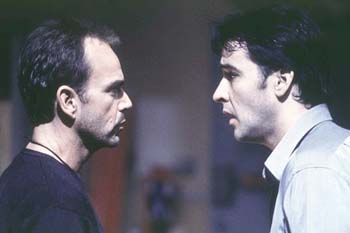![[Metroactive Movies]](/movies/gifs/movies468.gif)
[ Movies Index | Show Times | Metro | Metroactive Central | Archives ]
Unhappy Landings
Heavyweight Flighters: John Cusack (right) and Billy Bob Thornton square off in 'Pushing Tin.'
'Pushing Tin' flies under the radar
By Richard von Busack
'SATURDAY NIGHT LIVE" once ran a parody of Jerry Lewis movies with comedian Robert Klein as the wacky air-traffic controller. Pushing Tin fits the mold. This awkward serio-comic film ends with a healthy dollop of Lewis' own brand of mush. John Cusack plays Nick "The Zone" Falzone, a hot-shot air-traffic controller who becomes embroiled in a rivalry with a newcomer on the job. Russell Bell (Billy Bob Thornton) possesses cool credentials: he's half-Choctaw, drives a motorcycle and is a nondrinker in a hard-partying group. He also has a sexy wife, Mary (Angelina Jolie). Bell's gravity and coolness infuriate the terrierlike Falzone, who ups the ante by sleeping with Mary. Russell warns Nick--in an indirect New Age kind of way--that two can play at that game, and so Bell befriends Falzone's wife, Connie (Cate Blanchett of Elizabeth).
Pushing Tin is surprisingly similar to 1987's equally rickety Tin Men, in which comic rivalry escalates when one party sleeps with his nemesis's wife. The film isn't Cusack's fault; he's uncompromisingly arrogant, just as Richard Dreyfuss was in Tin Men. Thornton may consider himself to be more of a reactor than an actor; here, he's inert, a reactor off-line. Director Mike Newell (Four Weddings and a Funeral) never untangles the material. It's strange to see a British director skirt labor issues as Newell does. Part of the reason Pushing Tin fails is that it ignores--for political reasons--the real problems air-traffic controllers have. The movie doesn't include even a passing reference to President Reagan's mass firing of controllers for striking in the mid-'80s. Nor does it mention the obsolete equipment that bedevils the profession. The source of Pushing Tin is Darcy Frey's 1996 article for the New York Times Magazine, in which he explains how six-day work weeks and alternating shifts keep the controllers stressed, sleepless and prone to breakdowns. The workers are forbidden to strike by federal law. (In Pushing Tin, it's the desire to excel that ruins Nick's life. Mainstream movies get as shy as maidens when it comes time to mention the bottom-line reasons behind workplace stress.)
Pushing Tin is written by Glen and Les Charles, who created the TV show Cheers. The rhythms of the sitcom show all though the movie: garrulous quarrel picking, apropos-of-nothing insults, zingers that don't zing. And there's the same TV-style last-minute ramming in of "heart," which keeps the film stuck in a cinematic holding pattern at the finish. The two enemies have to patch up at a trout stream; the fractured marriage of Nick and Connie has to be glued back together with a sentimental song. Pushing Tin is neither comedy nor drama nor romance nor hard-boiled, serious film about workplace stress, but it has bits and pieces of all these sorts of pictures: this film is the most misshapen critter this side of The Island of Dr. Moreau.
[ San Jose | Metroactive Central | Archives ]
![]()

Joe Lederer
Pushing Tin (R; 128 min.), directed by Mike Newell, written by Glen and Les Charles, based on an article by Darcy Frey, photographed by Gale Tattersall and starring John Cusack, Billy Bob Thornton, Cate Blanchett and Angelina Jolie.
From the April 29-May 5, 1999 issue of Metro.